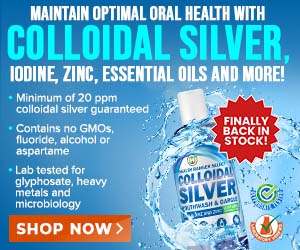
FDA Opens Public Comment for Safety of Mercury in Dentistry (Action Alert)
Friday, May 23, 2008 by: Teri Lee Gruss
Tags: mercury fillings, health news, Natural News
- CLOT SHOT PLANDEMIC UNFOLDING: Fibrous, rubbery clots caused by covid injections have prion-like seeding activity
- Widespread social and economic unrest: Steve Quayle issues urgent financial warning of imminent asset collapse in new interview with Mike Adams
- DEATH by VACCINE or face PRISON time: Canadian Freedom Convoy leaders CONVICTED for protesting forced vaccination during the Covid Plandemic
- How to detox from metals falling out of the sky
- Aerosolized bioweapons? Strange “diploid biomasses” falling out of the sky in Florida captured under the microscope
- How Israeli military-connected corporations are secretly controlling your online privacy
- How the peanut allergy epidemic was fueled by faulty science and institutional arrogance
- Kiss Your Genetic Privacy Good-Bye! 23andMe Gets Green Light to Sell Your Intimate Genetic Details to Anyone They Want
- Analysis: The coming economic collapse, a mass uprising and Trump's three secret weapons to halt the growing revolt
- Thimerosal is 50 percent MERCURY and NO it has NOT been removed from vaccines - that was a BIG FAT LIE the CDC told vax skeptics to keep them vaxxed up and dying
- “Rockefeller Medicine Men”: Today’s healthcare crisis stems from the creation of the American medical establishment
- Mike Adams releases country western hit single: Goin’ Back in Time is Comin’ Home
- Global financial Ponzi scheme collapses in real time as markets plummet, Mike Adams and Steve Quayle warn of impending chaos
- EU takes aim at Elon Musk's X with potential $1 billion fine under Digital Services Act
- Defunding DEADLY mRNA jabs: Government funding for mRNA technology being scrutinized and sidelined until proven "safe and effective" for real
- European Court of Justice: Healthcare professionals who promoted or administered COVID-19 vaccines are CRIMINALLY LIABLE for any harm caused
- New York governor signs controversial gun control measure, sparking Second Amendment concerns
- Washington State expands hate crime bill but ignores left-wing violence against Tesla owners
- Aerosolized bioweapons? Strange “diploid biomasses” falling out of the sky in Florida captured under the microscope
- European Court of Justice: Healthcare professionals who promoted or administered COVID-19 vaccines are CRIMINALLY LIABLE for any harm caused
- Newly released JFK files reveal Pentagon's role in creating Lyme disease and covid in the same lab
- Analysis: The coming economic collapse, a mass uprising and Trump's three secret weapons to halt the growing revolt
- FBI imposed gag order on agents to silence Hunter Biden laptop truth before 2020 election, new chat logs reveal
- Britain’s descent into police state censorship: Parents raided for questioning their daughter’s school system online
- “Project Aldrin”: Senate probes Meta's alleged censorship dealings with China
- Kiss Your Genetic Privacy Good-Bye! 23andMe Gets Green Light to Sell Your Intimate Genetic Details to Anyone They Want
- Oncologist warns of ‘terrifyingly aggressive’ cancers in children, linked to immune suppression from COVID vaccines
- Mike Adams releases country western hit single: Goin’ Back in Time is Comin’ Home
- Utah governor allows ban on LGBT pride flags in public buildings and schools, will take effect without his signature
- AI-powered forecasting model proves more accurate than traditional systems at predicting the weather
- When antibiotics are unavailable, natural ANTIMICROBIAL compounds become essential first line defenses against infection
- German researchers find link between mRNA vaccines and GENETIC CHANGES that precede CANCER and AUTOIMMUNE DISORDERS
- Defunding DEADLY mRNA jabs: Government funding for mRNA technology being scrutinized and sidelined until proven "safe and effective" for real
- The Health Ranger releases “Vaccine Zombie” song and music video, using AI-animated zombies for the music video
- Dr. Mary Talley Bowden drops bombshells about children being permanently damaged by mRNA jabs during Tucker Carlson interview
- The hidden war above: Chemtrails, HAARP and the battle for planetary control
- Newly released JFK files reveal Pentagon's role in creating Lyme disease and covid in the same lab
- California's social media censorship law struck down: A victory for free speech or a threat to online safety?
- The Health Ranger releases “Vaccine Zombie” song and music video, using AI-animated zombies for the music video
- Dr. Mike Yeadon releases 15-minute testimony - WATCH - about genocidal intent of COVID “vaccines”
- EPA advisor admits the agency is funneling billions to climate groups ahead of Trump’s return to White House
- Rep. Nancy Mace introduces bill to ban biological males from female facilities on federal property
- Mike Adams releases country western hit single: Goin’ Back in Time is Comin’ Home
- Florida takes a stand: DeSantis proposes permanent ban on mRNA vaccine mandates
- Sugarcane extract superior to cholesterol-lowering drugs?
- Survival 101: Effective EMF blocking techniques
- OpenAI whistleblower who dissented against how the company trained ChatGPT found dead
- CONSERVATIVES SOUND THE ALARM: Big Pharma and the Left trying to force $32 billion money grab from America’s seniors into year-end spending deal
- Pilots report mysterious lights 'moving at extreme speeds' across Oregon skies
- Attorney and TikTok influencer explains how he was offered hundreds of dollars to make false claims about Trump, Republicans
- Trump reverses course on Gaza plan, says “nobody is expelling Palestinians”
- Trump expected to choose Kelly Loeffler as his agriculture secretary even though she was caught INSIDER TRADING during COVID
- MEDICAL BOMBSHELL: FDA admits Covid mRNA 'Vaccines' CAUSE CANCER
- Marketing director responsible for WOKE Jaguar rebrand is also an LGBT activist who supports Black Lives Matter
- Red Cross issues warning to stop blood plasma donations from vaccinated people
- Scientists confirm: GENIUS brain function can be spontaneously unleashed in humans without any apparent cause
- EPA advisor admits the agency is funneling billions to climate groups ahead of Trump’s return to White House
- HYSSOP: What research reveals about the health benefits of this ancient holy herb
- Two containers with completed ballots fall out of truck in Florida
- Fully vaccinated about to see “tsunami” of illness and death, warns virologist
- Global leaders unite to clamp down on “misinformation” with UN-backed Cascais Declaration
- Newly released JFK files reveal Pentagon's role in creating Lyme disease and covid in the same lab
- BREAKING: 2025 NDAA authorizes mandatory military draft of WOMEN across America… as Pentagon pursues global NUCLEAR war with both Russia and China at the same time
- Michael Yon warns of a ZIONIST TAKEOVER in Trump’s second administration
- Ozempic and Wegovy weight loss drugs are injectable LIZARD VENOM PEPTIDES that may unleash a devastating wave of organ failure… side effects align with symptoms of SNAKE BITES
- BOMBSHELL: DNA testing kits are a SCAM to develop ethnic-specific bioweapons
- The Health Ranger releases “Vaccine Zombie” song and music video, using AI-animated zombies for the music video
- Israeli soldiers accused of even more torture and abuse in the West Bank
- These 13 countries just signed an agreement to engineer a global FAMINE by destroying food supply
- NASA admits that climate change occurs because of changes in Earth’s solar orbit, and NOT because of SUVs and fossil fuels
- RFK Jr. clears key hurdle: Sen. Susan Collins backs controversial HHS nominee, signaling a new era for health policy
- Sermon 30: How Jesus reveals Caesar’s FAKE CURRENCY and FALSE AUTHORITY
What does this mean for the average person that has eight mercury amalgams in their mouths?
The EPA notes that the ongoing National Health and Nutrition Examination Survey (NHANES) found that, between 1999-2000, about 8% of 16-to-49 year old women had blood mercury concentrations greater than 5.8 ug/L . "Based on this prevalence for the overall U.S. population of women of reproductive age and the number of U.S. births each year, it is estimated that more than 300,000 newborns each year may have increased risk of learning disabilities associated with in utero exposure to methyl mercury."
Fish contains mercury in the form of methyl mercury. Dental amalgams contain elemental mercury, which can be methylated by microorganisms once inside the human body. The EPA has established a daily reference dose (RfD) of 0.1 µg/kg body weight/day of methyl mercury, "without recognized adverse effects". Methyl mercury is the most toxic form of mercury.
Dental amalgams are approximately 50% mercury and 50% a mix of silver, copper, zinc and tin. The higher the copper content the more hazardous the amalgam material becomes. Certain metals interact with one another in the mouth in a process called galvanism. Saliva bathing dissimilar metals, mercury and copper, produce an electric current and promote corrosion of the amalgam. Corrosion increases mercury vapors absorbed.
When the price of silver increased in the 1970's amalgam manufacturers, to keep costs down, increased the copper content of amalgams. These amalgams are called non-gamma-2 (high copper) and are even more toxic than prior mercury amalgam formulations. Ask your dentist if you and your children have high copper mercury amalgams in your mouths.
The EPA says that "improved substitute materials are now available" and that "amalgam use is in decline". Why use a metal known to be hazardous to the environment and to the human central nervous system when there are other, safer materials readily available? Isn't it time to ban mercury amalgams?
Several well organized consumer and professional groups including Consumers for Dental Choice and the International Academy of Oral Medicine and Toxicology (IAOMT) have requested that the FDA address the hazards of mercury amalgams (fillings) used in dentistry. The intensity of their request escalated back in 2002. These groups have been instrumental in lobbying and taking legal action against the FDA for its continued refusal to rule on the safety of dental mercury.
Mercury amalgams are currently classified by the FDA as Class II medical devices. The medical device classification system consists of three levels, Class I, which include bandages and tongue depressors, regulated by "general controls". Class II devices, subject to "special controls", include amalgams and powered wheel chairs. Class III devices require "pre-market approval" and include silicone breast implants and heart valve replacements.
Anti dental mercury groups would like to see amalgams placed in the latter group, Class III medical devices. This would place the burden of proof of safety on amalgam manufacturers. Prior to 2002 mercury amalgams were Class I medical devices, like bandages and tongue depressors.
After years of FDA inaction, in December 2007 a lawsuit was filed against the troubled agency for its failure to address mercury safety. Possibly this pressure has led to the agency announcement to reopen public comment on mercury amalgam safety.
For whatever reason, the FDA comment period is a real opportunity for all of us who are concerned about the known health risks of having this toxic heavy metal in our mouths and the mouths of our children. Cognitive dysfunction and neurodegenerative disorders including Alzheimer's, Parkinson's and MS have all been linked to mercury toxicity.
Norway, Sweden and Denmark have all recently banned mercury amalgams because of its toxicity to humans and the environment. According to Norway's Environmental Minister, Erik Solheim, "Mercury is among the most dangerous pollutants. Good alternatives to mercury exist already and it is therefore right to introduce this ban."
Sweden, Canada and the U.K. have banned the use of mercury amalgams in pregnant women and children. With safe alternatives available it doesn't make sense to keep putting a material in our mouths that is shipped and disposed of as a "hazardous material".
While we await a FDA ruling on dental mercury, shouldn't we, at the very least, insist that our dentists provide us with an "Informed Consent" form which lists possible risks of mercury amalgams and optional and safe materials available. This is really an issue of health freedom of choice.
To learn more about the hazards of mercury amalgams visit (http://www.toxicteeth.org/) and (http://iaomt.org/) .
Take this opportunity to let the FDA know how you feel about the dangers of mercury in dentistry. Public comment is open until July 28, 2008. Also consider sending a copy of your comments to your elected Congressional representatives.
Docket ID: FDA-2008-N-0163
Docket Title: Dental Devices: Classification of Encapsulated Amalgam Alloy and Dental Mercury and Reclassification of Dental Mercury; Issuance of Special Controls for Amalgam Alloy; Reopening of Comment Period
To file an electronic comment:
(http://www.regulations.gov) In the search box enter: FDA-2008-N-0163
To fax a written comment:
301.827.6870
To mail a comment:
Division of Dockets Management(HFA-305)
FDA
5630 Fishers Lane, Room 1061
Rockville, MD 20852
Additional reading:
(http://www.fda.gov/ohrms/DOCKETS/dockets/05p...)
(http://www.fplc.edu/risk/vol2/spring/royal.h...)
About the author
Teri Lee Gruss, MS Human NutritionMercury fillings at FETCH.news
Get independent news alerts on natural cures, food lab tests, cannabis medicine, science, robotics, drones, privacy and more.
Take Action: Support Natural News by linking to this article from your website
Permalink to this article:
Embed article link: (copy HTML code below):
Reprinting this article:
Non-commercial use OK, cite NaturalNews.com with clickable link.
Follow Natural News on Facebook, Twitter, Google Plus, and Pinterest
Science News & Studies
Medicine News and Information
Food News & Studies
Health News & Studies
Herbs News & Information
Pollution News & Studies
Cancer News & Studies
Climate News & Studies
Survival News & Information
Gear News & Information
News covering technology, stocks, hackers, and more



"Big Tech and mainstream media are constantly trying to silence the independent voices that dare to bring you the truth about toxic food ingredients, dangerous medications and the failed, fraudulent science of the profit-driven medical establishment.
Email is one of the best ways to make sure you stay informed, without the censorship of the tech giants (Google, Apple, Facebook, Twitter, YouTube, etc.). Stay informed and you'll even likely learn information that may help save your own life."
–The Health Ranger, Mike Adams












































